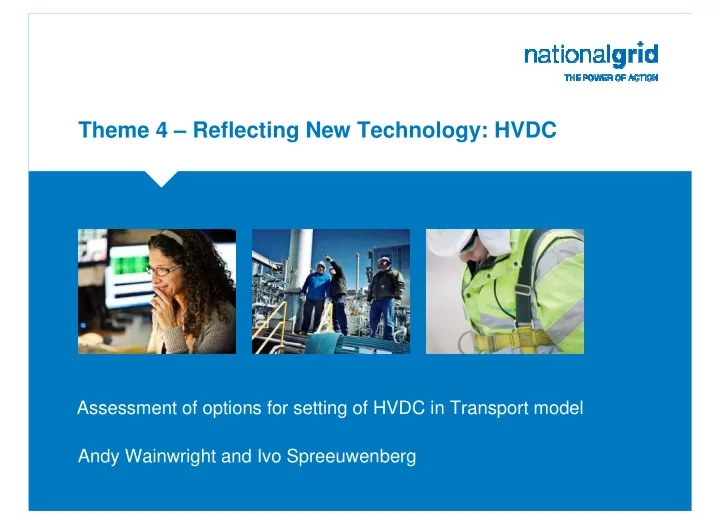

Theme 4 – Reflecting New Technology: HVDC Assessment of options for setting of HVDC in Transport model Andy Wainwright and Ivo Spreeuwenberg
Reflecting HVDC in Transport Model � Offshore HVDC links – ‘Bootstraps’ � Existing charging model based on passive network elements � HVDC represents an active component of the network � Therefore in Transport model need to; 1. estimate level of power flow 2. calculate desired impedance 2
Options for calculating power flow 1. Optimal Power Flow Derive power flow from optimal operation calculation - complex 2. Transmission Routes Assume equal power flow on each double circuit equivalent route 3. Transmission Circuits Assume equal power flow on each major circuit 4. Circuit Ratings Pro-rata flows based on circuit ratings 3
Managing Multiple Boundaries � Options 2-4 assume flow setting based on single boundary management B2 B5 � In reality each bootstrap B6 B4 crosses multiple boundaries B7 � Option 4B – managing multiple boundaries through B11 ratings B16 4
Proposed simplifying assumptions � Flows based on Transport Model background (Year Round) � Boundary with fewest onshore circuits used for single boundary approach – most constrained boundary; B6 � 3 onshore double circuit routes � 132kV circuits ignored for options 2&3, i.e. 4 circuits on 2 routes considered, due to relatively small size (capacity approx. 6% of 400kV) 5
2015 Western HVDC Example � Step 1 – Ascertain total rating of circuits across boundary in Transport model including HVDC � B6 total = 10844MW 2330MW 111MW 1875MW 2330MW 132MW 1875MW 2000MW 6
2015 Western HVDC Example � Step 2 – Ascertain flow across boundary in Transport model YR background without HVDC � B6 total = 5889MW 1388MW 11MW 1860MW 1388MW 28MW 1213MW X 7
2015 Western HVDC Example Step 3 – Calculation of desired HVDC flow. For single boundaries*; 2. Transmission Routes BF MW * HVDC cap / N R 3. Transmission Circuits BF MW * HVDC cap / N C 4. Circuit Ratings; a. single boundary BF MW * HVDC cap / BR Where; BF MW = MW boundary flow from Transport model with no HVDC HVDC cap = MW capacity of HVDC circuit N R = No. of routes across boundary N C = No. of circuits across boundary BR = total rating of boundary 8 *Note: Optimum power flow method not investigated
2015 Western HVDC Example � Step 3– Calculation of HVDC flow. For option 4B; � Need to repeat 4A calculation for each boundary crossed � In this case; � B6 required HVDC flow = 1086MW rating = 10844MW B6 flow = 5889MW � B7 required HVDC flow = 740MW � B11 required HVDC flow = 651MW rating = 13634MW � B16 required HVDC flow = 753MW B7 flow = 5047MW rating = 26298MW B11 � Multiple boundary flow = 9208MW result is average of four boundaries rating = 33490MW B16 flow = 13364MW 9
2015 Western HVDC Example Results 2. Transmission Routes Desired flow: 1963MW 3. Transmission Circuits Desired flow: 1178MW 4. Circuit Ratings; a. single boundary Desired flow: 1086MW b. multiple boundaries Desired flow: 808MW 10
Impact on tariffs � Desired flows need to be converted into impedances in Transport model � Matrix developed for this calculation � Table contains Transport model input assumptions 11
Impact on tariffs – generation � Only full cost EF results shown for clarity 50 40 30 Tariff (£/kW) 20 No HVDC 2C 10 3C 0 4aC 4bC -10 -20 1 2 3 4 5 6 7 8 9 10 11 12 13 14 15 16 17 18 19 20 Generation Zone � 2 – Routes; 3 – Circuits; 4a – Ratings (single); 4b – Ratings (multiple) � 2011/12 Revenue + 2015/16 Transport Model 12
Recommend
More recommend